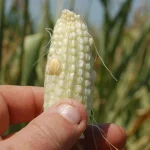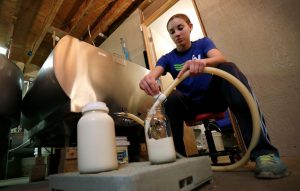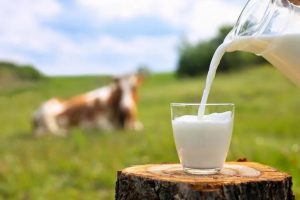
The state in recent years has eased regulations on meat processing, selling chicken eggs and homemade baked goods, but still has the most restrictive raw milk rule in the region.
Ablonde cow named Punky munches on a clump of deep-green alfalfa and orchard grass, her bottomless brown eyes fixed on the spot where her newborn calf is hidden in the tall weeds.
Farmer Doug Wiley will load the hours-old calf and his jersey-Brown Swiss cow into a trailer later today headed from the pasture to the milking barn. Punky has too much milk for the baby bull to drink on his own, though the cow will nurse her calf for the next few months. They’ll spend their days moving from pasture to pasture, chasing the thickest and greenest grasses.
From the peaceful farm east of Pueblo, where yellow sulphur butterflies hover above the fields and the cows seem like they’re living their best lives, comes perhaps the most controversial food product in Colorado: raw milk.
Selling raw milk, which is not pasteurized, or cooked, to kill any harmful bacteria, is illegal in this state. The only way to get it legally is to become one of the owners of a herd of cows or goats, because farmers are allowed to consume their own products.
Wiley, who wears a red cap that says “Make Milk Raw Again,” has about 250 shareholders, each of whom has signed a bill of sale to become part owner of his herd of 40 milk cows. The shareholders sign contracts specifying that Wiley will care for and milk the cows, and that the shareholders will pay a boarding fee of $57 per month. There is a waiting list, and no one can sign a bill of sale before touring Larga Vista Ranch and meeting the cows.
Each share comes with one gallon of raw milk per week, which shareholders must pick up by driving dirt roads through the sorghum and cornfields of Pueblo County, or meeting at the drop-off spots in Colorado Springs. In other words, they really want it.


Doug Wiley shows a fridge of half-gallons of milk bottled that week. The yellow tint of raw milk is due to its concentration of vitamin A, he said. (Olivia Sun, The Colorado Sun via Report for America).
About one-third of Wiley’s shareholders say they cannot digest pasteurized milk. Some are putting it in bottles for their babies. All go through the trouble of buying part of a cow herd because they believe raw milk is healthier, providing enzymes that they say helps digestion, and has a richer, sweeter taste.
The Raw Milk Association of Colorado maintains that before milk is pasteurized, it’s a “living rich food” that contains colloidal minerals, vitamins A, C and B, and enzymes that aid in the digestion and absorption of the milk’s sugars and fats. “The alteration of foods and their nutrient content over the course of the last century has had long-term negative impact on the ability to maintain optimum human health and definitely worsens or initiates chemical and food sensitivities,” the association says.
The U.S. Food and Drug Administration banned the sale of unpasteurized milk across state lines in 1987, aiming to protect consumers from sickening and potentially deadly outbreaks caused by E. coli, salmonella and campylobacter. The FDA maintains there are no health benefits to drinking raw milk and that it’s unsafe, especially for children and older people. But states are free to make their own laws.
Lately, the debate over raw milk is taking on new energy as part of the “food freedom” movement. The push for more farm-to-table food and less government interference has led Colorado policymakers in recent years to loosen restrictions on local, custom meat processing and pass the Cottage Foods Act, which lets people sell goods made in their own kitchens, no license or inspection required.
Still, Colorado’s rules on raw milk are stricter than in any of its eight surrounding states and most of the West.
In Wyoming, Oregon, Montana, Nebraska, Kansas, Oklahoma and Texas, farmers are allowed to sell raw milk directly to consumers, such as straight from the farm or at farmers markets. Retail milk sales are legal in Utah, Idaho, Washington, Arizona, New Mexico, Nevada and California.

Colorado governor supports legalizing raw milk
A farmer who operated dairies in Loveland and Chaffee County is credited with developing the herd-share concept to sell raw milk in Colorado. State law bans its sale, but doesn’t prevent farmers from eating or drinking their own products straight from the farm.
The arrangement was nearly banned in 2004, though, when regulators at the Colorado Department of Public Health and Environment who knew about the herd-share option announced they were considering a rule change. Raw milk farmers and shareholders protested by the dozens, and public health officials backed off. Then in 2005, the legislature passed a law stating that a “consumer with an ownership interest in the cow, goat or herd” can obtain raw milk.
When a 2010 outbreak linked to raw goat milk from Longmont sickened 30 people and hospitalized two children, state health department warnings about raw milk resurged and there were renewed calls for stricter policies, such as creating consequences for people who get milk through a herd share and then give it to others. But the herd-share rule remained intact.
Then this summer, the Colorado Libertarian Party offered to make a deal to help Republicans get elected if they would, among other promises, pledge to support raw milk. The state Libertarian Party vowed it would not run in competitive legislative districts when the GOP candidate agrees to vote to cut taxes and “support food freedom, such as raw milk and local meat processing.”
State law requires raw goat and cow milk dairies that sell shares to register with the state health department, though they are not inspected. They also must include a warning about the potential risks, and shareholders are not allowed to share their milk with others, though it’s unclear whether there are consequences for violating that part of the rule.
The Raw Milk Association of Colorado lists more than 230 farms that sell raw milk, including options for milk from sheep, yaks and camels.
Colorado, with its independent spirit, is likely to eventually see a coalescence of freedom-loving libertarians, Republicans supporting farmers’ rights, and Democrats in favor of nonprocessed food choices to rally around raw milk, said Dan Waldvogle, director of the Rocky Mountain Farmers Union.
This doesn’t seem far off. Gov. Jared Polis, a Democrat with libertarian leanings, is already on board, telling The Sun this week that he hopes Colorado moves to “fully legalize the production and sale of raw milk, properly labeled, so that those who prefer it are able to legally obtain it with greater ease.”
The governor said people should have the freedom to choose whether to drink raw milk, pasteurized milk or no milk. “Compared to many other choices that are fully legal, including fatty foods and excess alcohol, the risk of raw milk is low,” Polis said via email.


LEFT: Kristin Hay picks up bottles of raw milk at the Colorado Farm and Art Market in Colorado Springs, where milk is distributed to shareholders. RIGHT: Doug Wiley helps customers choose pork and beef products at the market. (Olivia Sun, The Colorado Sun via Report for America)
Waldvogle, with the farmers union, said he felt he was in a “back-alley drug deal type of situation” when he was part of a herd share and picked up his weekly raw milk in Salida, literally in an alley. “And God forbid if I was out of town that Friday,” he said, explaining why he dropped out. “We were paying a premium and we weren’t drinking all the milk.
“Food safety should be paramount,” he said. But “our policy absolutely supports informed consumers being able to assess risk … putting consumers in the driver’s seat.”
“That was enough of an uphill battle to create the raw milk allowances that we even have now,” he said. “You get one person in there that says the word ‘salmonella’ and gets everyone worked into a frenzy. But there has got to be a balance to make sure you are creating access.”
The food-freedom movement is even more evident in other states.
Iowa, where the legislature had waved off previous attempts to legalize raw milk, passed a law allowing direct sales from farmers to customers this year. Wyoming in 2015 passed the “Food Freedom Act,” allowing farmers to sell raw milk and other farm goods directly to customers and at farmers markets, though not in retail stores. The law was a step up from the herd-share model Wyoming raw dairy producers had been using.
This year, Wyoming lawmakers were debating mayonnaise, clarifying that “potentially hazardous” products, such as those that contain raw eggs, are included among the homemade goods that people can sell.
“Raw milk is a superfood and I really think people are realizing that again,” said Christine Hampshire, who has grown from one family milk cow at her Wyoming farm to milking 12 cows to meet demand. She sells the milk at a farmers market that’s open four days per week and includes goods from other producers.
Aron Lam, mayor of the Weld County town of Keenesburg and a libertarian, said it’s time that raw milk policies evolve, arguing that animals raised naturally on small farms are kept clean and treated like pets. Besides, he said, people should have the right to eat what they want.

Raw milk is a superfood and I really think people are realizing that again.
— Christine Hampshire, who sells raw milk in Wyoming
He ran as leader of the small plains town northeast of Denver along Interstate 76 on a “food freedom” platform. One of his first acts as mayor was to get the town council to repeal its prohibition on residents selling chicken eggs to their neighbors.
“There is risk versus benefit to everything in life,” he said. “If some people think the small risk of illness outweighs the health benefits, I don’t think it should be the government stepping in to say, ‘You can’t do this.’”
Lam pointed to data from the federal Centers for Disease Control and Prevention, which advises against drinking raw milk, indicating about 3% of Americans regularly drink raw milk yet there are only a handful of outbreaks reported each year.
But the CDC says that as more states have allowed raw milk sales, outbreaks are increasing. Places where raw milk was legally sold had 3.2 times more outbreaks compared with areas where it was illegal, according to one study that spanned 1998-2018. In the six years from 2007-12, 26 states reported 81 outbreaks linked to raw milk, resulting in 979 illnesses.
Colorado has had 14 outbreaks linked to raw milk since 1989, according to data from the state Department of Public Health and Environment. Those outbreaks sickened 247 people, and included a 2016 outbreak at Wiley’s Larga Vista Ranch in Pueblo County that resulted in 17 people falling ill.
“Skim milk is a disaster”
Wiley, his face shaded by a wide-brimmed straw hat as he walks through the cow pasture in rubber boots, says he knows what happened to cause the foodborne illness that health officials traced back to his farm nine years ago. He had been in the hen house just before milking his cows and must have carried some campylobacter bacteria on his hands.
Since then, there has been a strict policy on the ranch that no one milks a cow without first scrubbing up.
He lost a couple of shareholders because of the outbreak, but also got calls from people who wanted to sign up when they heard there was raw milk for sale in Pueblo County. People who get food poisoning from campylobacter typically have diarrhea, fever and stomach cramps.
In the milk barn, four cows line up at a time in an operation that looks about as far from a mass commercial dairy as exists. Each cow has their udder washed with an iodine solution before they’re attached to a milking machine. The milk is carried down a tube through the wall and into a room where cows aren’t allowed. There, it’s stored in a stainless steel tank at 37 degrees. Later, Wiley and his two workers transfer the milk to half-gallon glass or plastic jugs that line the shelves of a refrigerator until pickup or delivery day.
The milk has a yellowish tint, not white like the pasteurized, store-bought kind, and it’s sweeter, though Wiley says he can taste a difference in the flavor depending on what grasses his cows are eating. As the milk jugs sit, the cream rises, creating a thick layer at the top. It’s best to shake it before pouring, unless someone is trying to hog the creamiest part for themselves.
“Most of the little children that come and sign up and try the milk say it’s like drinking a milkshake,” he said. “The last time I tried to drink store-bought milk it was like, oh ugh, no wonder people are coming to me.”
Wiley, the youngest of five brothers who grew up on the dairy farm, drinks a half-gallon every day. After he eats in a restaurant, he drinks a tall glass of milk at home because he says it helps him digest. “Skim milk,” he said, “is a disaster that should never have been put on the population.”
Before Wiley began selling raw milk shares about two decades ago, customers were driving from Pueblo County to as far away as Loveland to get raw milk.
Wiley’s parents operated a commercial dairy for decades, but had to sell off their cows, equipment and part of their land in the farm bust of the early 1990s. He studied agronomy at Colorado State University and returned to the farm, where he began working the land that his family has farmed for 100 years. He grows vegetables organically, without pesticides, and typically plants onions, beets, sweet corn and melons. He raises grass-fed beef and pasture-raised pork. His animals don’t receive antibiotics or vaccines. The cows eat only grass and a molasses supplement, no grain.

The last time I tried to drink store-bought milk it was like, oh ugh, no wonder people are coming to me.
— Doug Wiley, farmer at Larga Vista Ranch
“Nutrition isn’t necessarily a starting point in discussions of farming and agriculture and it needs to be,” Wiley said. “If we started there, then raw milk would be part of the conversation. It all starts with nutrition. You just don’t one day quit vaccinating. You have to have good minerals in the soil.”
Wiley’s goal is raising the most nutritious food possible while properly caring for the land.
He doesn’t till the fields with a tractor, but instead rotates his cows and pigs from plot to plot by using a pig-tailed post to lift the wire of an electric fence and move its borders. The cows eat the ryegrass, alfalfa and orchard grass, leaving behind the thistle. Then the pigs come along, rooting up the ground and eating the thistle roots.
The soil, Wiley says, is dense with nutrients and minerals from decades of proper management. This summer, when there was abundant rain, the grass grew lush and multiple varieties of crickets moved in to sing like a chorus. The grasshoppers are gigantic.
The dozen animals in the pasture with Punky and her new calf, including Essie and Scarlett, are almost all either nursing or pregnant. A few acres away, young heifers and bulls are in their own square of land, where they breed naturally.
“The trick to making that most nutritious food is covering up the soil,” he said. “We’ve had these 100-degree days and the soil is protected. The beauty of pasture is complex and diverse, and weeds are part of it.”

Her son was hospitalized because of raw milk
Mary McGonigle-Martin doesn’t care how idyllic the farm is or how pretty the cows are. “They lie in manure,” she said. “This movement makes it sound like if you just raise the cow as God intended, then your milk is safe.”
The California mom became a food safety advocate 17 years ago, after her then 7-year-old son ended up in the hospital for two months with hemolytic uremic syndrome that threatened to destroy his kidney function. The boy was sickened by E. coli after drinking raw cow’s milk that McGonigle-Martin had purchased at a grocery store near her home in Murrieta, Calif., hoping that maybe it would help with his attention deficit disorder.
Two and a half weeks after buying the milk, McGonigle-Martin’s son got severe diarrhea and was rushed to the hospital.
McGonigle-Martin, who is on the board of the Chicago-based organization Stop Food Illness, said public health officials are losing ground on protecting the public from raw milk. She has testified before policymakers across the country, including multiple times in Iowa, and watched as national raw milk advocacy groups, including the Weston A. Price Foundation, have built support in various states for food-freedom policies.
On top of that, TikTok and Instagram, where influencers are touting the health benefits of raw milk, are not helping, she said.
“On social media they make it sound so good that I think that is outweighing the public health message,” she said. “It’s just people saying, ‘I’m drinking raw milk. It’s great! It’s healing my body! You should drink raw milk.’”
Promoters have spread “propaganda” that pasteurized milk is a processed food, McGonigle-Martin said. “We’re in a time where you don’t want to eat processed food. I am all for eating healthy and a lot less processed foods, but people have to understand that milk is an entirely different medium.”
She puts milk in the same category as meat — it requires cooking to kill the pathogens.
“People could do it safely for five, six, seven years and not have a serious illness happen, and then one day, it happens,” she said. “I think that’s the hard part.”
In some areas, raw milk is entwined with homeschooling, among families who want to buy natural food from small farmers. That’s distressing to McGonigle-Martin, who found that most of those who’ve been hospitalized because of raw milk were children. “This really is a crime,” she said. “They market to pregnant women and children. This is the base they want buying the milk.”
Shareholders seek raw milk for its health benefits
Wiley has never gotten sick from raw milk. No one in his family, not even his 90-year-old mother, fell ill in the 2016 outbreak blamed on campylobacter bacteria.
They speculate it’s because they grew up on the land, with the cows and pigs and chickens. Kids who grow up on dairy farms drinking raw milk also have a lower incidence of asthma and allergies, according to one study.
For Kenneth Gardner, a shareholder in Wiley’s herd since 2007, raw milk is part of an organic food regimen that he says prevents him from having health problems or disease.


LEFT: Kenneth Gardner, a Larga Vista shareholder since 2007, helps unload bottles of raw milk at the Colorado Farm and Art Market in Colorado Springs. Gardner gets a majority of his food and groceries from local sources and farms, and frequently makes kefir out of Larga Vista’s milk. RIGHT: More customers pick up bottles of raw milk. Shareholders must tour the dairy at Larga Vista before completing cow-share paperwork for the state. (Olivia Sun, The Colorado Sun via Report for America).
“Pasteurized milk is toxic,” he said while picking up his raw milk share at a Colorado Springs farmers market. “It’s not good for your body. I don’t ever drink (pasteurized) milk and I hardly ever go out to eat because the food sources of all the restaurants are basically the same — they’re all from the big food giants.”
Gardner and his brother go through about two gallons of milk per week, he said. They drink it, but also make kefir, which is fermented and the texture of yogurt or cottage cheese. He traces the origin of his pure and raw food diet back to the early 2000s, when he read “Fast Food Nation,” an expose about the U.S. fast-food industry and, specifically, McDonald’s.
“I just got more and more religious about what I put in my mouth,” he said.
Mariah Maza, another shareholder of Wiley’s herd, is pregnant and has two kids who are 2 and 3 years old. She switched to raw milk after hearing it had more nutrients, and talking about it via text with her deployed husband.
“I felt a lot better about giving my kids milk before bed or giving them milk as a snack, and I just felt better about what I was feeding them,” she said. “And I’m pregnant right now so I’m really glad to have raw milk to drink.”
Part of it, too, is knowing the guy who is handling the milk and how the cows live on the farm, Maza said. “I think they’re very specific about how they grow their crops and how they treat the cows, and everything’s organic,” she said. “So that was really important to us, too.”
Colorado Sun photographer Olivia Sun contributed to this report.

























